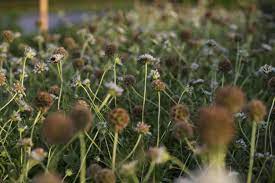Pincushion Flower Plant
Pincushion Flower (Scabiosa) is a perennial that grows 1-2 ft tall, hardy in USDA Zones 3-7, prefers well-drained, loamy soil, full sun to part shade, medium moisture, and has no edible or medicinal uses.

Habit
Clump-forming
Height
0.3 to 0.5 m
Growth
Perennial
Soil
Well-drained, Loamy
Shade
Full Sun
Moisture
Moderate
Edible
No
Medicinal
No
Origin
Europe, Asia
Climatic Condition
Temperate, Subtropical
Temperature (°)
15°C to 25°C
Humidity (%)
50% to 60%
Potting media
50% Loam, 40% Sand, 10% Compost
Fertilizers
Organic Fertilizer
Watering
Regular watering
Plant Weight
0.2 to 0.5 kg
Flowering Time
Summer to Fall
Soil Ph level
6.0 to 7.5
Water Ph level
6.0 to 7.0
Soil EC
0.5 to 0.8 mS/cm
Yield Per Plant
1 to 2 kg per plant
NPK ratio
10:10:10
life Span
2 to 3 years
Health Benefits
Ornamental, Medicinal
Suggested Grow Media or Potting Mix ?
50% loamy soil, 30% compost, 20% sand
Suggested Fertigation/Fertilizers
Fertilize every 4 weeks with a balanced, water-soluble fertilizer.
Common Diseases and Remedies
Powdery Mildew, Gray Mould, Leaf Spot, Aphids, Root Rot.
White powdery growth on leaves Gray, fuzzy mold on leaves and flowers Brown or black spots on leaves Yellowing leaves, sticky residue on leaves Wilting, yellowing leaves, root discoloration
Neem oil, baking soda spray Improve air circulation, remove affected parts Remove infected leaves, use compost tea spray Insecticidal soap, ladybugs Improve soil drainage, use beneficial soil microbes
Sulfur-based fungicides, Iprodione or thiophanate-methyl, Copper-based fungicides, Insecticides containing imidacloprid, Fungicides with metalaxyl or mefenoxam.
HEALTH BENEFITS
· Wound Healing: Traditional medicine uses it for minor cuts and burns.
· Antimicrobial Properties: Some species have antibacterial effects.
· Attracts Pollinators: Supports a healthy ecosystem.

